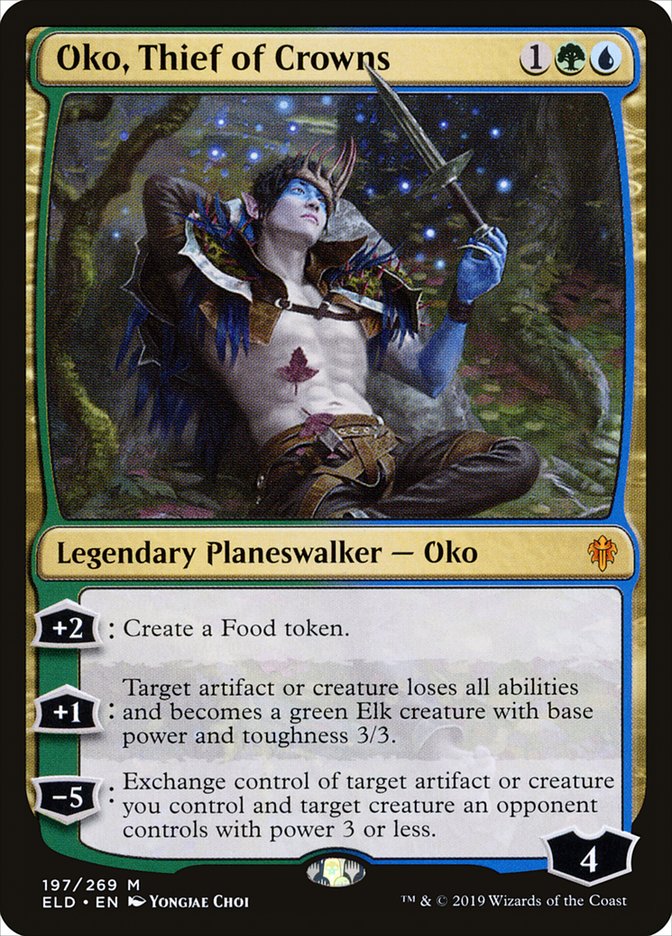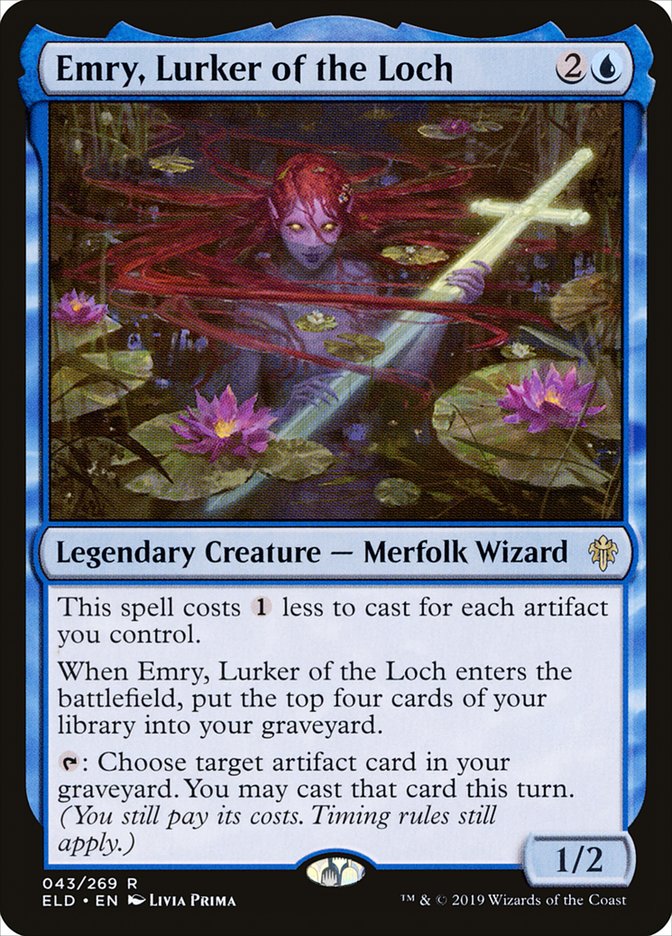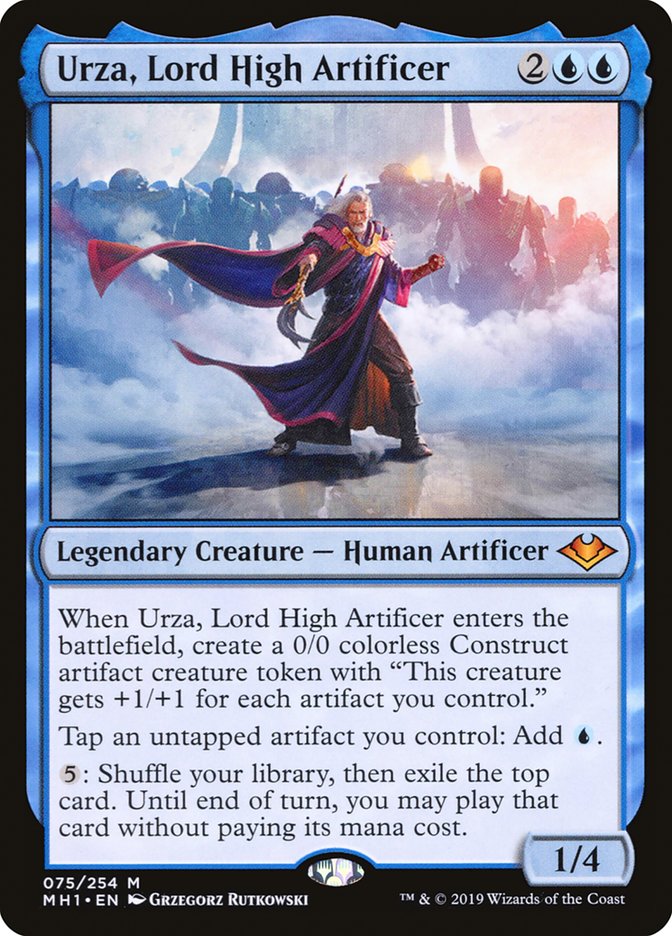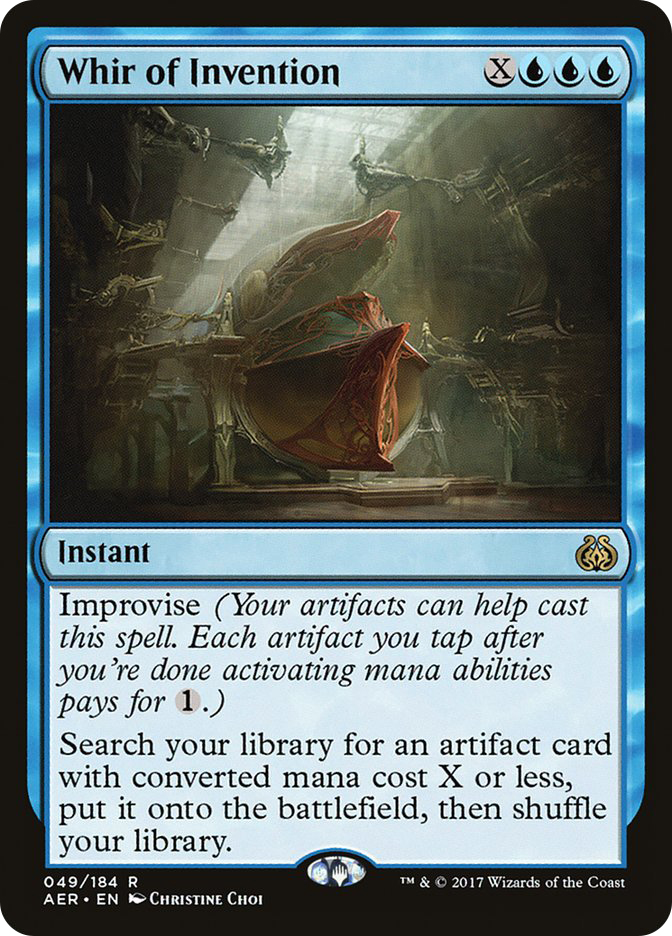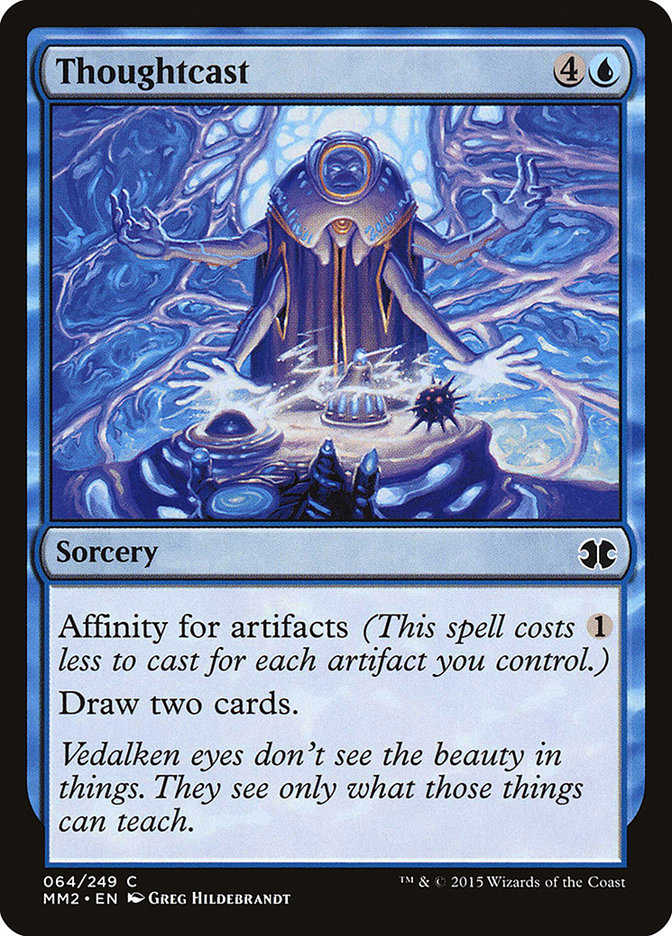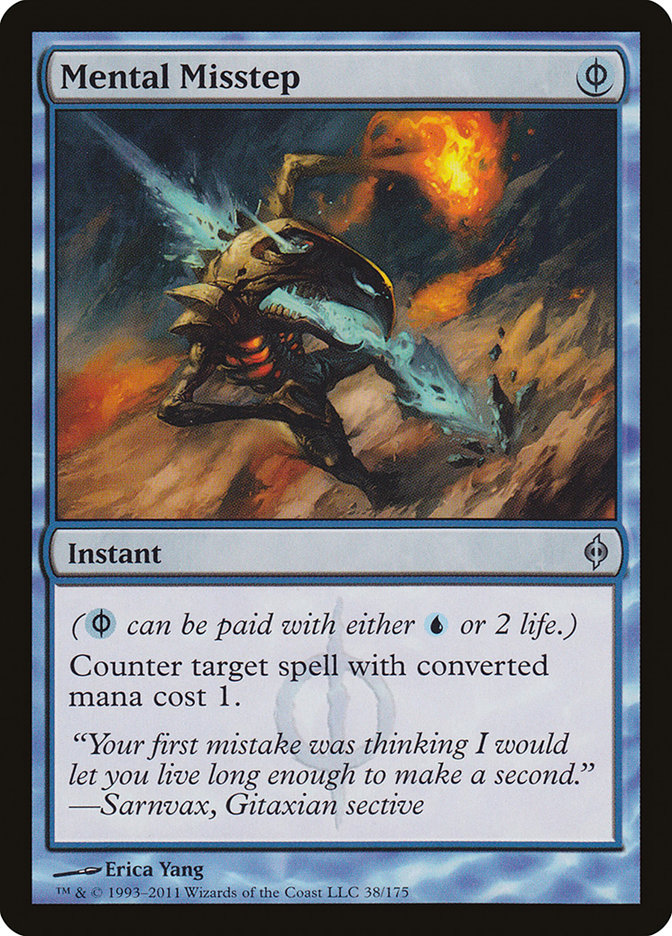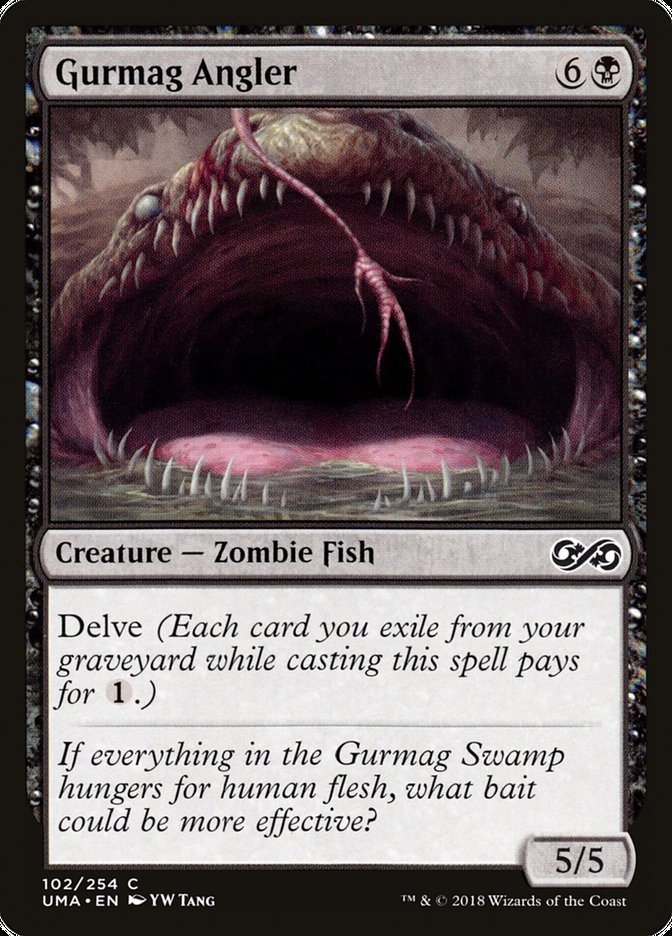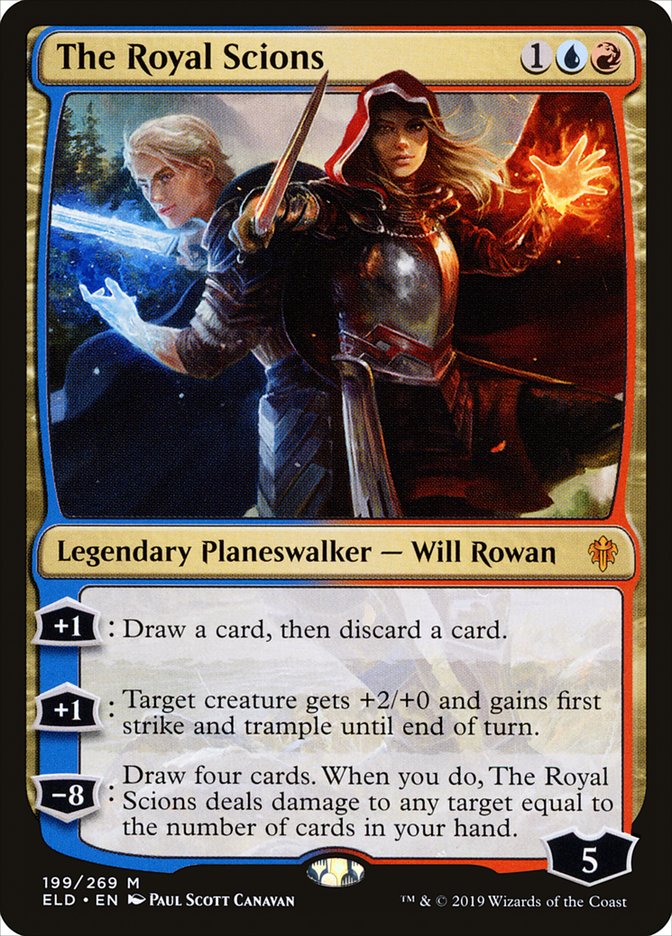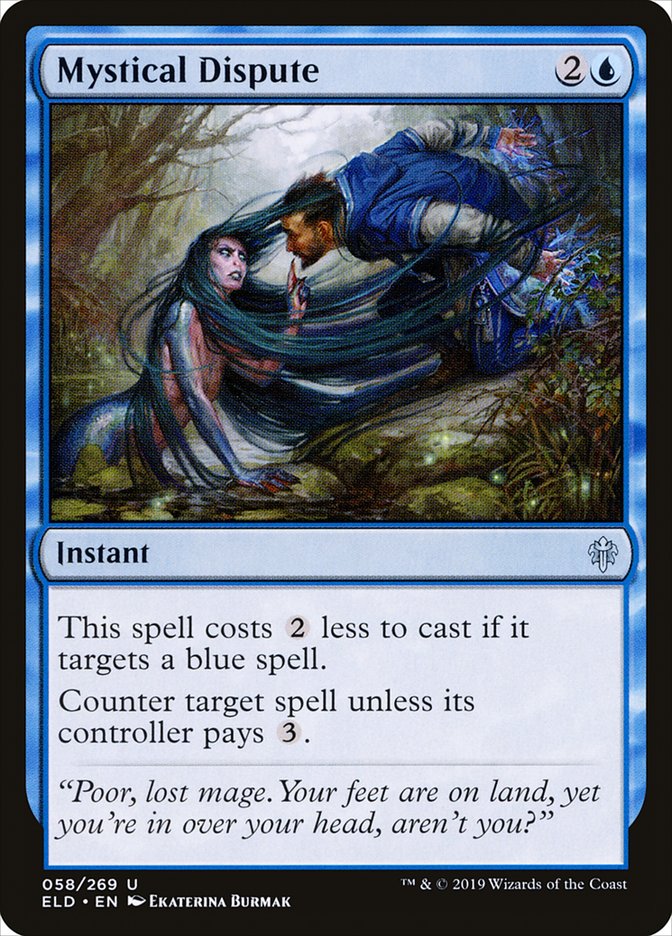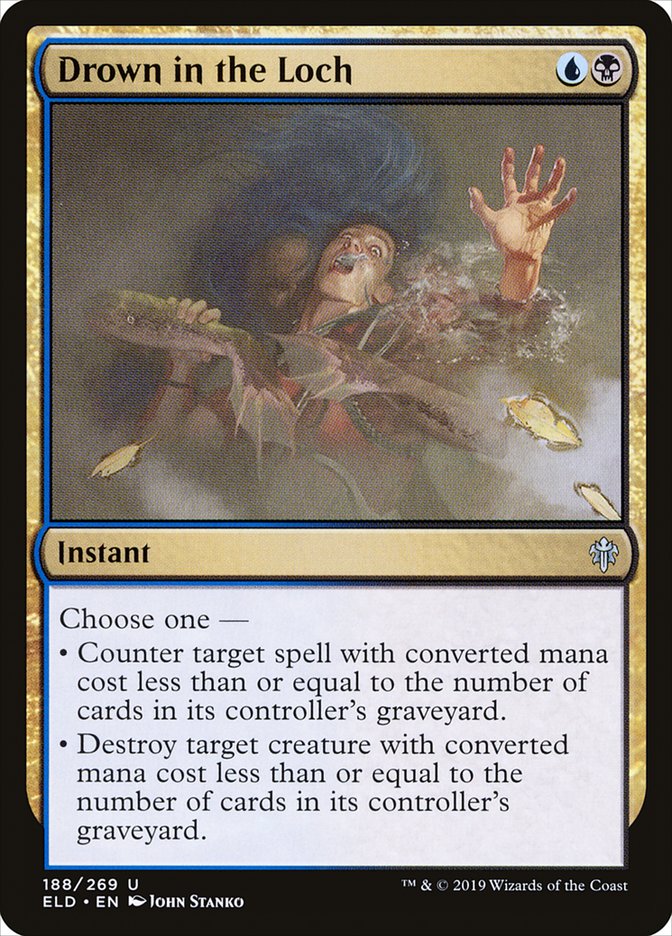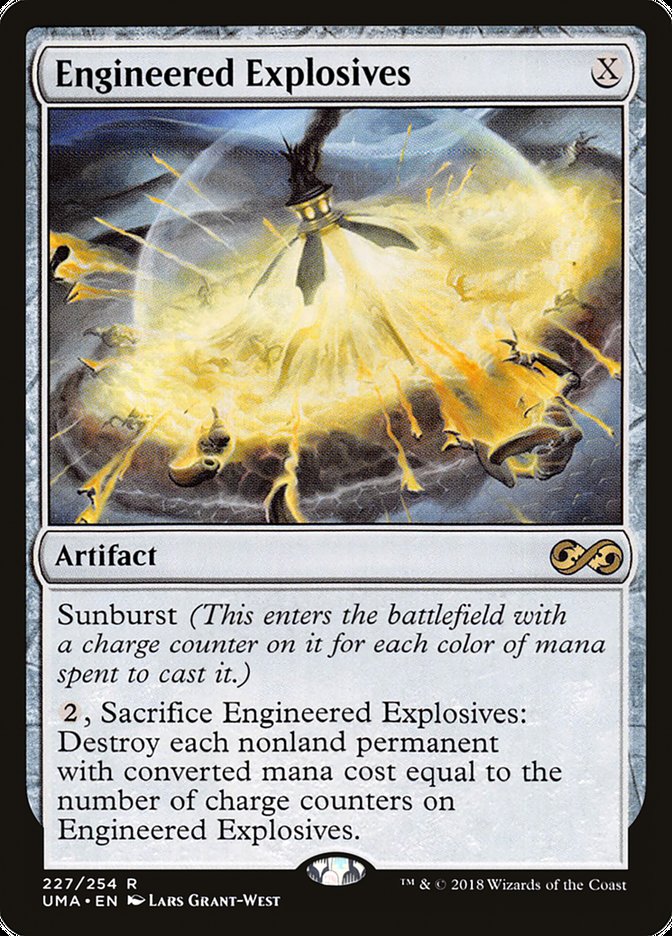For the Season Two Invitational at SCG CON Winter, there are really only two serious choices for the enterprising player looking to crush the Modern portion:
Simic Whirza, and Grixis Death’s Shadow.
That’s it. Whirza is far above the curve in terms of power level, making good use of the collection of broken artifacts and artifact-adjacent creatures and planeswalkers that got printed in the last year.
Like all busted decks, Simic Whirza integrated a full infinite combo right on top of a fair, consistent value shell with a healthy helping of disruption. Imagine Jund with more broken starts, a tutor package, and multiple insane end-game loops.
If it isn’t the Turn 1 Emry, Lurker of the Loch recurring Mishra’s Bauble that gets them (basically Dark Confidant), it’s the Urza mana advantage that buries them. If it’s not the Urza mana advantage, it’s the Thopter-Sword combo (which, of course, goes infinite with an Urza on the battlefield).
If it’s not the Thopter-Sword combo, it’s Urza’s activated ability churning through the deck. If it’s not that, it’s Oko turning random copies of Arcum’s Astrolabe, Mox Opal, or Engineered Explosives into 3/3 Elks every turn and getting aggressive.
If it’s not Oko turning everything into an Elk, it’s Cryptic Command looping with Mystic Sanctuary. Yep, this deck loops Cryptic Command and Mystic Sanctuary. With two Commands, you can counter a spell and return your own Sanctuary to your hand. Then you can replay the Sanctuary to put the first Cryptic Command back on top, and repeat with the second Cryptic Command. It also works with Emry, Lurker of the Loch and Mishra’s Bauble, which churns an extra card and keeps the loop running.
I count no fewer than five disparate angles of attack that the average opponent will have to contend with in order to win. Then there’s the tutor package with Whir of Invention, which can grab Pithing Needle, Grafdigger’s Cage, Damping Sphere, or Ensnaring Bridge to lock out opponents, or just find half of the Thopter-Sword combo to generate an army of tokens and a pile of life.
To be fair, there are two different builds of this deck available, one with a Whir of Invention package and one with Thoughtcast in order to churn faster. The Whir package includes Thopter Foundry and Sword of the Meek, while the Thoughtcast one eschews that combo in order to churn through the deck faster and grind through disruption better.
Here are the best examples of the two lists from recent tournaments:
Creatures (12)
Planeswalkers (4)
Lands (19)
Spells (25)

Collins Mullen list of Simic Whirza is quite strong, but Edgar Magalhaes offers a slightly different take, if one expects less need of a tutor package and more cheap velocity and card advantage:
Creatures (12)
Planeswalkers (4)
Lands (19)
Spells (25)

The pieces fit together beautifully here. Gilded Goose is Deathrite Shaman in this deck, offering a limited quantity of mana advantage (limited, of course, by land cards in the graveyard in Deathrite’s case, and Food availability in Goose’s) while simultaneously giving a bit of extra life in a pinch. While Deathrite Shaman offered Grixis Delver decks a bit of reach via exiling an instant or sorcery, Gilded Goose offers more in the synergy department for decks that care specifically about artifact permanents. In one shining example, a player can cast Emry, Lurker of the Loch on Turn 2 off a Gilded Goose by “locking in” the mana cost at 1U before actually paying for the spell by sacrificing the Food.
Similarly, Food tokens generate mana from Urza, turn into Elks from Oko, tap for Whir of Invention or Metallic Rebuke, activate metalcraft on Mox Opal, and trade with key opposing creatures from Oko’s -5 ability. Imagine stealing an opponent’s Urza, Lord High Artificer and giving them a measly Food!
To be frank, Mox Opal is not long for Modern. It seems like the card enables the kind of broken starts that push decks beyond what the rest of the format can keep up with. This wasn’t so bad when the only broken starts enabled by Mox Opal were linear aggro decks like Affinity, or even sticky-threat decks like Scales. It got bad with Krark-Clan Ironworks, which was eventually banned. It’s bad again with Urza, Lord High Artificer, which may itself get banned in lieu of the busted zero-mana accelerant. But the fundamental principle stands: effects like this are simply Legacy- or Vintage-level power in a format where the fair decks don’t have the tools to interact on the correct timeframes.
I still say unban Mental Misstep, Faithless Looting and Deathrite Shaman if you’re going to allow Mox Opal to be a part of Modern. Let’s get these broken decks on equal footing and give a much-needed shot in the arm to the fair decks!
The alternative is to roll back the last few months of sets. Start banning egregious cards aggressively. Emry, Urza, and Oko are all on the watch list, though likely only one or two needs to go to bring back a bit of balance. Wrenn and Six; Arcum’s Astrolabe; Teferi, Time Raveler; Narset, Parter of Veils; Once Upon a Time; and more have all upended the formats in less-than-healthy ways.
But banning talk isn’t the focus here. Hypothetical alternate Modern formats don’t exist right now, and as it stands, only a small subset of the format is still able to tussle with Urza, Mox Opal, and friends on equal footing.
Though it’s overall a less-powerful deck, the disruptive Grixis Death’s Shadow is where you want to be when it comes to fighting Simic Whirza.
Let’s look at the winner’s list from the Atlanta Open several weeks ago:
Creatures (15)
Planeswalkers (1)
Lands (17)
Spells (27)

The more things change, the more they stay the same. With The Royal Scions replacing the occasional Jace, Vryn’s Prodigy as the supplemental card selection piece in one of the small flex slots, the core of the deck is exactly the same as it’s been for two years now. And with a combo deck incorporating numerous somewhat fragile creatures exploding onto the scene, it’s the perfect time for the most interactive deck in Modern to rear its ugly head and get back into the game.
John Holland got the list from Dylan Donegan, who personally advocated for it as the one non-Mox Opal deck he’d be willing to play in Modern. And yes, despite not having the correct fetchlands (see the Misty Rainforests where Scalding Tarns should be?), John ran roughshod over a bunch of vulnerable Simic Food decks en route to the trophy.
What gives?
Well, Gurmag Angler gives. The big Fish is by far the best threat against Simic Oko, which has plenty of Engineered Explosives to recur against Death’s Shadow. Gurmag basically says “Oko or bust” against Simic, which is the same basic situation that used to occur between Grixis Death’s Shadow and Ironworks Combo. Between Grove of the Burnwillows and Engineered Explosives, it was ridiculously difficult to stick a Death’s Shadow through opposing defense. Gurmag Angler didn’t care, though. It’s a key piece of Modern right now, as the threat-answer dance steps towards the high converted mana cost of the one-mana 5/5.
It’s easy to slip an Angler on the battlefield on Turn 3 between the sequence of various Fatal Pushes and Thoughtseizes. Follow it up with a couple more pieces of interaction and it will close out the game swiftly.
The Royal Scions, though small, is a noticeable upgrade as a noncreature threat against control decks (the threat being that by going ultimate, you’re likely to win the game with a massive influx of new cards and a big bolt at an opposing Jace, the Mind Sculptor or even the opponent’s face). It also acts as a surrogate Temur Battle Rage for Death’s Shadows, though it can never deal the full twenty by itself. Sometimes a 12/10 first strike, trample creature is all you need.
Sideboarding with Grixis Death’s Shadow against a deck like Simic Whirza is challenging specifically for all the reasons that Simic Whirza is a great deck. The multiple angles of attack mean that it’s not really possible to cut creature removal for more countermagic, nor is it advisable to cut countermagic for more creature removal.
Mystical Dispute is a sweet supplemental Stubborn Denial, catching Oko, Urza, and Emry with equal ease. It’s possible that it’s worth another copy in the sideboard, possibly over Disdainful Stroke depending on the density of Mono-Green Tron and Eldrazi Tron. (Although it wouldn’t surprise me in the future to see the Simic decks pick up more copies of Veil of Summer to absolutely embarrass Thoughtseizes, Mystical Disputes, and Stubborn Denials alike.)
The rest of the cards are pretty much the same as they’ve always been, and what remains is figuring out the perfect balance between low cost and flexibility. For example, Drown in the Loch is an exceptional split card when it’s active, and is likely worth a spot in the Death’s Shadow sideboard. However, it costs two mana, and therefore competes with all the other flexible interaction pieces like Collective Brutality, Abrade, and Disdainful Stroke. It would appear that we are back to the days of massaging the Grixis Death’s Shadow numbers in the flex slots to try to hedge against everything!
The alternative, for those who are feeling particularly inspired, is Four-Color Death’s Shadow. Four colors are key for incorporating the necessary Stubborn Denial in the list as well as the newest broken planeswalker on the block, Oko.
There are numerous legitimate ways to build Four-Color Death’s Shadow. Here’s my take, and where I will spend any non-Pioneer testing time before deciding if it’s better to pack it in and play Grixis:
Creatures (12)
Planeswalkers (3)
Lands (18)
Spells (27)

Once Upon a Time might be valid in this deck as well, as a supplemental Traverse the Ulvenwald that also boosts consistency on Turn 1 and boosts the graveyard for Tarmogoyf and Delirium. It’s worth trying out.
It’s also unclear if we need a second “real” red source, considering we have Wrenn and Six in the deck. Wrenn is a hyper-powerful card and works well with Nurturing Peatland, but the mana is stretched in multiple directions at this point and it becomes especially challenging to navigate everything. Especially against Azorius Control (one of the better spots to run out Wrenn and Six) it’s often risky to run out our single Blood Crypt in the face of Field of Ruin.
With straight Jund Death’s Shadow, everything comes together much more smoothly with regard to the manabase. Even with the red splash solely for Temur Battle Rage, there’s not much of an issue sequencing lands to get the Blood Crypt at the time you intend to use it. But with Wrenn and Six demanding red mana early, Oko needing blue, and Thoughtseize – Death’s Shadow turns necessitating double black mana, things get awfully dicey. It might be advisable to cut a basic Forest for a Stomping Ground in order to have more sources of all the colors, though that comes with its own risks against Path to Exile.
Additionally, Engineered Explosives cleans up this whole deck with impunity. At least there’s Abrupt Decay to actually remove resolved copies of Oko on the other side! Plus, with the addition of green comes Veil of Summer, which is a massive beating in semi-mirrors, where the last Death’s Shadow standing often wins. Veil of Summer even beats Abrupt Decay!
Regardless, the data is fairly clear. There are other options as always in Modern. I expect to see Mono-Green Tron, Eldrazi Tron, Amulet Titan, Humans, even Burn or Dredge. But Simic Whirza is a cut above the rest, and the Death’s Shadow decks are best-positioned to attack Whirza. So there we sit in our broken Modern metagame.


